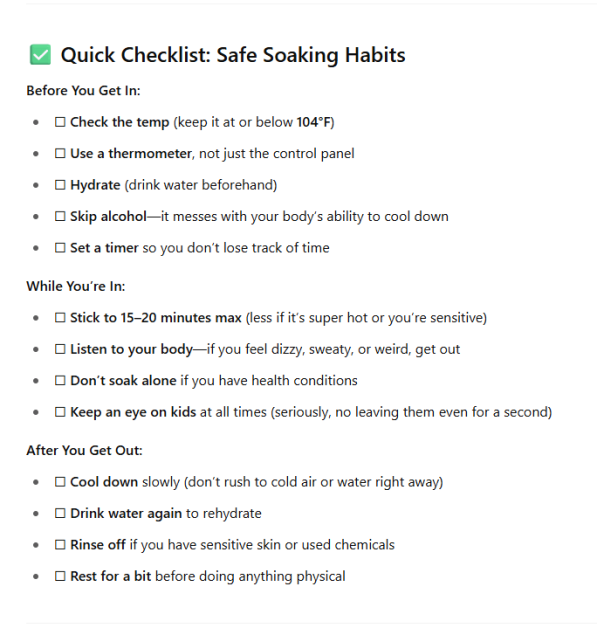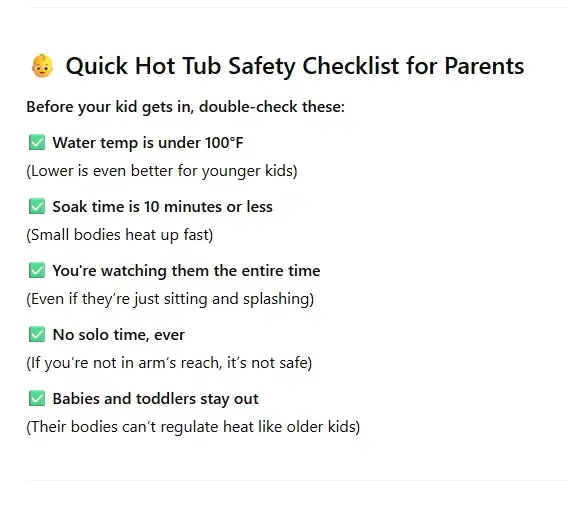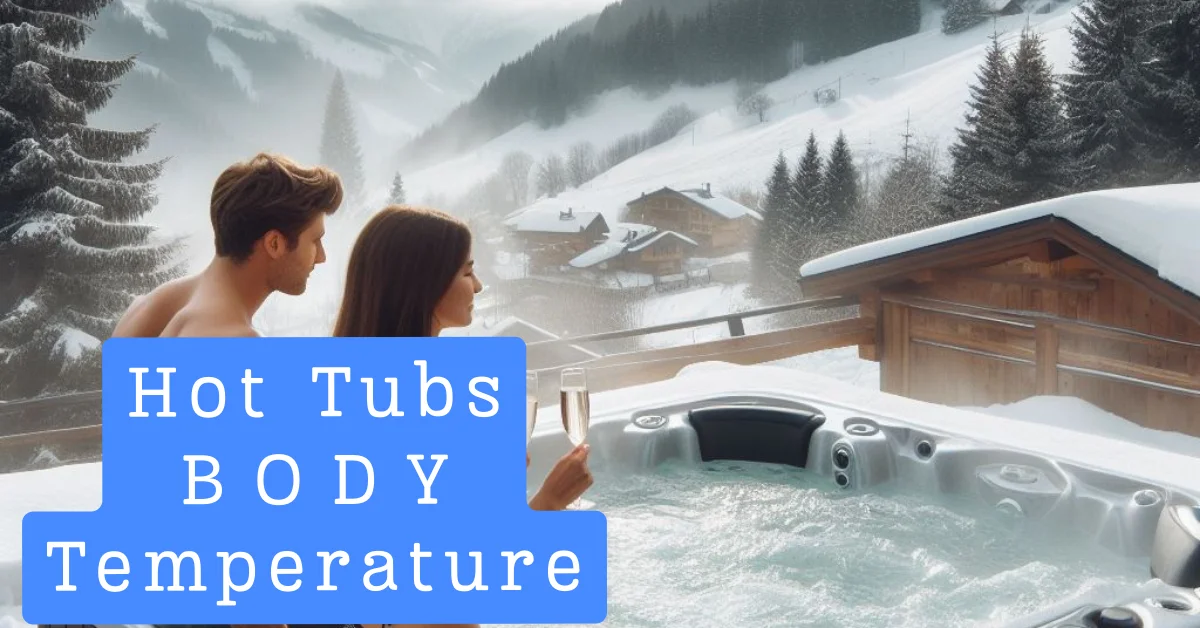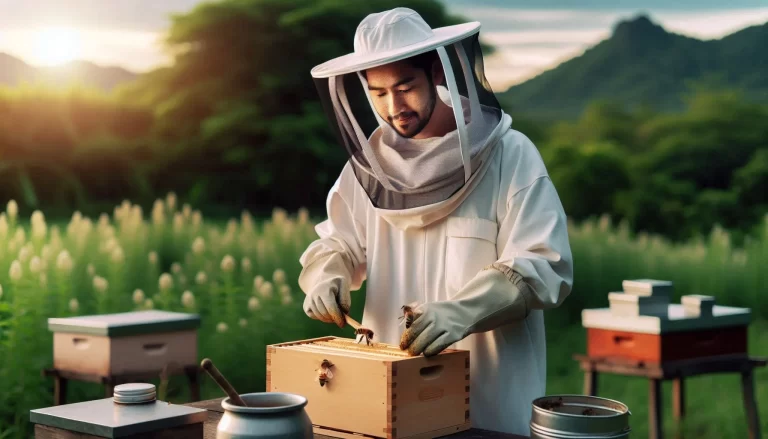Hot Tubs and Body Temperature: Stay Safe, Avoid Overheating
Hot tubs feel amazing, but they can quickly raise your body temperature. That might sound harmless, but overheating can lead to dizziness, nausea, or worse. So how hot is too hot, and how long should you stay in?
We’ll cover what happens to your body in hot water, how long it’s safe to soak, and when to step out. Curious about can you get pregnant in a hot tub? We cover that too.
What you’ll learn:
- Ideal soak times and temps
- Signs of overheating
- Health tips for safer soaking
- Simple water care tips
We cover all information base on our own experiance for safe hot tub temperatures, the potential risks of elevated body temperature, and how to enjoy the benefits of a hot tub responsibly.
How Hot Tubs Affect Body Temperature
- Your Body’s Thermostat: Your body maintains a remarkably consistent internal temperature, typically around 98.6°F (37°C). It does this through various mechanisms, like sweating to release heat or shivering to generate warmth.
- Hot Water Disruption: Soaking in a hot tub, especially one with water temperatures exceeding your body temperature, disrupts your body’s natural cooling processes. The hot water prevents efficient heat loss through the skin. Additionally, the warm environment can make sweating less effective for cooling.
- The Temperature Imbalance: As your body loses its ability to cool, your internal temperature rises. The longer you stay in the hot tub and the hotter the water, the greater the risk of your body temperature reaching unsafe levels.
Dangers of Elevated Body Temperature
- Mild Heat Exhaustion: When your body temperature rises too high, you might initially experience symptoms of heat exhaustion. These include:
- Dizziness or lightheadedness
- Nausea
- Headache
- Fatigue or weakness
- Heavy sweating
- Cool, clammy skin
- Muscle cramps
- The Threat of Heatstroke: If your body temperature continues to rise unchecked, heat exhaustion can progress into heatstroke – a medical emergency. Signs of heatstroke include:
- High body temperature (104°F/ 40°C or above)
- Confusion or altered mental state
- Throbbing headache
- Rapid breathing and pulse
- Flushed, hot skin
- Lack of sweating
- Loss of consciousness
- Increased Risk: Certain factors make some people more susceptible to heat-related illness:
- Age: Very young children and older adults are less efficient at regulating body temperature.
- Health Conditions: Heart disease, lung problems, obesity, or diabetes can increase risk.
- Medications: Some medications can interfere with your body’s cooling ability.
Important Emphasis:
Heatstroke requires immediate medical attention. If you suspect someone is suffering from heatstroke, call emergency services and begin cooling measures while awaiting help.
And if your water feels off, see how to raise pH in hot tub naturally.
Safe Hot Tub Practices
To minimize the risk of your body temperature rising to unsafe levels, follow these essential guidelines:
- Temperature Control: The maximum recommended hot tub temperature is 104°F (40°C). Always check the temperature with a thermometer before entering.
- Time Limits: Limit your soak time to 15-20 minutes at a time. If you start feeling overheated, get out of the hot tub immediately.
- Hydration is Key: Drink plenty of water before, during, and after using a hot tub. Dehydration can worsen the effects of heat.
- Avoid Alcohol: Alcohol impairs judgment and increases the risk of dehydration, making it a dangerous combination with hot tub use.
- Precautions for Certain Groups:
- Pregnant women: Elevated body temperature can be harmful to a developing baby.
- People with medical conditions: Before using a hot tub, people with heart conditions, blood pressure issues, or other health concerns should discuss this with a doctor.
Check out Hot Tub Use for Pregnant Women.
Additional Safety Considerations
- Check Before You Soak: Even if you’ve used a hot tub before, always check the water temperature with a thermometer. Settings can change, and it’s essential to be sure.
- Supervision is Crucial: Children, seniors, or anyone with health conditions should never use a hot tub unsupervised. Be vigilant to ensure their safety.
How Hot is Too Hot? And for How Long?
This is one of the most common questions. And honestly, it depends on who you are and how your body handles heat.
Most hot tubs max out at 104°F, which is fine for healthy adults for short periods. But that doesn’t mean you should treat it like a long bath. Different people have different limits.
Here’s a quick cheat sheet:
| Who | Temp Range | Safe Soak Time |
|---|---|---|
| Healthy adults | 100 to 104°F | 15 to 20 minutes |
| Older adults | 98 to 100°F | 10 to 15 minutes |
| Kids (under 12) | 95 to 100°F | 5 to 10 minutes (max!) |
| Pregnant women | 98 to 100°F (max) | 10 minutes or less |
| People with conditions | 95 to 99°F | Talk to your doctor first |
A few quick tips:
- If you’re new to hot tubs, start lower on both time and temp.
- Feeling lightheaded, sweaty, or uncomfortable? Get out and cool off.
- Don’t forget to drink water. It’s easy to get dehydrated without realizing it.
Also, if you’re soaking with kids or someone with health conditions, don’t leave them unattended. Hot water affects people differently, and it can sneak up on you fast.
Want to stay in longer? Drop the temp a little and take breaks.
Check out Drinking in a Hot Tub: What You Need to Know.
How Do You Know If You’re Overheating?
Hot tubs feel amazing… until they don’t. If your body starts getting too warm, it’s not always obvious right away. That’s why it’s good to know the warning signs before things go sideways.
Think of overheating like a sliding scale. Here’s how it usually plays out:
Stage 1: Heat Fatigue (Mild but Pay Attention)
You’re still doing okay, but your body’s saying, “Hey, this is a bit much.”
- You feel flushed or kinda warm all over
- Light sweating starts
- Maybe a slight headache or you’re just not as chill anymore
- Your heart rate picks up a little
At this point, you should probably hop out and cool off. No shame in taking a break.
Stage 2: Heat Exhaustion (Okay, Now It’s a Problem)
Now your body’s having a harder time coping.
- You feel dizzy, weak, or just “off”
- Nausea kicks in (ugh)
- Skin feels clammy or cool, even though you’re in hot water
- Lots of sweating, rapid breathing
- Legs feel heavy, like you could just slide right under (not good)
This is where hot tub time officially turns into too much time. Get out, sip water, and cool down immediately.
Stage 3: Heatstroke (Emergency Mode)
This is rare in hot tubs, but it can happen, especially if you’re alone, drinking, or pushing limits.
- Skin feels hot and dry (your body stops sweating altogether)
- Confusion, slurred speech, or trouble staying awake
- Throbbing headache
- Racing heart
- Loss of consciousness
Call for medical help ASAP. Heatstroke isn’t something you can just “sleep off.” While you wait, move the person to a cooler spot, fan them, and get cold water on their skin.
Quick Reminder
If you’re starting to feel weird, don’t tough it out. Get out of the water. Cool down. Drink some water. Sit somewhere shaded or inside. Listen to your body before it turns into a bigger issue.
Hot tubs are for relaxing, not overheating. Keep it safe and enjoyable.
Why Do Hot Tubs Sometimes Get Too Hot on Their Own?
So you set your hot tub to 100°F, walk away, come back later… and it feels more like 106. What’s going on?
Hot tubs can overheat all by themselves sometimes, even if you didn’t crank the temp. Here’s why it happens:
1. The Sun’s Doing Overtime
If your hot tub’s out in direct sunlight (especially with the cover on), it can heat up like a greenhouse. The water just keeps getting warmer, even if the heater’s off.
2. Insulation Holds Heat Too Well
Most hot tubs are made to keep heat in, which saves energy, but also means they don’t cool off quickly. If you use the tub at night and it’s a warm day, the temp can climb just from trapped heat.
3. Filter Cycles Add Heat
Your hot tub runs filter cycles during the day to keep the water clean. Thing is, the pumps running during those cycles can generate heat too. Not a lot… but enough to slowly raise the temp over time.
4. Thermostat Isn’t Always Spot-On
Let’s be real, some hot tub thermostats aren’t exactly precise. If the sensor’s off even by a couple degrees, it might be heating past your set temp without you knowing it.
5. Hot Weather + Insulation = Heat Trap
On really hot days, the combo of warm air, sunlight, and your tub’s thick insulation turns it into a heat trap. Especially if you’re not using it and the cover stays on all day.
Quick Fixes if Your Tub’s Running Too Hot
- Crack the cover open for a while and let some of the heat out
- Turn the temp down a few degrees before a hot day
- Adjust your filter cycle settings (shorter times help)
- Move it to shade if possible, or throw up a patio umbrella
- Double-check your thermostat or use a floating thermometer to get a second opinion
What Are Some Other Risks Besides Overheating?
Hot tubs are awesome for unwinding, no doubt. But beyond just getting too hot, there are a few sneaky side effects you might not think about, especially if you stay in too long or crank the temp too high.
Let’s break it down.
1. Skin Irritation or Heat Rash
If your skin starts feeling itchy or blotchy after soaking, you’re not imagining it.
- Hot water can strip away your skin’s natural oils, leaving it dry or irritated
- Sitting too long in heat and humidity can cause heat rash, especially around your back, legs, or neck
- And don’t forget, leftover chlorine or unbalanced pH can also mess with your skin
If you’ve got sensitive skin, keep your soaks shorter and rinse off afterward.
2. Blood Pressure Rollercoaster
Hot tubs mess with your circulation, sometimes in ways that aren’t great.
- The heat makes your blood vessels widen (called vasodilation), which can lower your blood pressure
- That’s why you might feel dizzy or a little “floaty” when you stand up after soaking
- If you already have low blood pressure, this can hit harder
If you’re prone to lightheadedness, just take it slow when getting out. No sudden moves.
3. Male Fertility Can Take a Hit
Yeah, this one surprises people.
- High heat can reduce sperm count for a few weeks, sometimes longer if you’re soaking often
- The testicles need a cooler environment to produce healthy sperm, and hot tubs kinda mess with that
If you or your partner are trying to conceive, it might be smart to hit pause on long, steamy soaks. Better safe than sorry.
Keep It Balanced
None of this means you can’t enjoy your hot tub. Just be aware of what’s happening under the surface (literally). Your body’s great at telling you when it’s had enough, as long as you’re listening.
Shorter soaks. Lower temps. Stay hydrated. And don’t stay in longer just because it feels nice.
Feel free our Quick Checklist Safe Soaking Habits

Important Note
The information in this article from Hot Tub Patio is intended for general knowledge. It is not a substitute for professional medical advice or treatment. Always consult a healthcare provider before making any changes to your health routine regarding any health concerns.
Hot Tubs, Pregnancy, and Fertility: What You Should Know
Hot tubs can wait. Relaxation doesn’t have to come with a risk. If you’re pregnant or trying, it’s totally okay to be cautious, better that than stressing later. If you’re ever unsure, always check with your doc.
Here’s what you need to know:
Pregnancy and Hot Tubs: Play It Safe
Soaking in hot water might sound like a great idea when you’re dealing with backaches or stress. But during pregnancy, especially in the first trimester, your body’s internal temp matters a lot.
When your core temperature goes over about 101°F, it can potentially increase the risk of certain birth defects, especially early on (like neural tube issues). It’s rare, but it’s not worth the gamble.
General safety tips for pregnancy:
- Keep the water below 100°F
- Limit soak time to under 10 minutes
- If you start sweating, getting flushed, or feeling off, hop out
- Avoid fully submerging your belly (sitting on the edge with just your legs in is a good workaround)
- Always check with your OB or midwife before soaking
Trying to Conceive? Here’s the Deal for Both Partners
This part doesn’t get talked about enough, but it matters.
For guys:
Hot tubs can lower sperm count, sometimes for weeks. The testicles need to stay a bit cooler than body temp to produce healthy sperm. Sitting in 104°F water doesn’t help with that.
If you and your partner are trying to get pregnant, regular hot tub use might be something to hit pause on for a bit.
For women trying to conceive:
Same idea as pregnancy, too much heat can affect ovulation or implantation in some cases. It’s not as cut and dry as with sperm health, but again, safer to stick with short, cooler soaks or warm baths instead.
Safer Soaking Options
If you’re craving that relaxing vibe without the heat risk, try this instead:
- A warm bath (around 98°F or body temp)
- Epsom salt foot soak surprisingly relaxing
- Gentle stretching or a prenatal massage
- Sitting on the edge of the hot tub with feet in (no full-body soak)
Are Hot Tubs Safe for Kids?
Short answer? Kinda but only if you’re really careful.
Hot tubs and kids don’t always mix well. Their smaller bodies heat up way faster than adults, and they can’t always tell you when they’re starting to feel woozy or overheated.
Here’s what you need to know before letting the little ones take a dip.
🚫 Babies and Toddlers (Under 5)
Nope. Just skip it. The water’s way too hot for them, even at lower temps. Plus, they can’t regulate body temperature the way adults can, and overheating can happen fast. Most pediatricians say no hot tubs for kids under 5 not even with supervision.
👍 Older Kids (5 to 12)
They can join in, but with strict limits.
Safety tips:
- Keep the water temp under 100°F
- Limit soak time to 5–10 minutes max
- Make sure they’re tall enough to sit with heads above water at all times
- No diving, no horseplay (save that energy for the pool)
- Absolutely no unsupervised time, you should be within arm’s reach
👀 Watch for These Signs
Kids may not speak up when they feel off, so watch for:
- Red cheeks or looking flushed
- Sluggishness or suddenly feeling sleepy
- Complaints of a headache, tummy ache, or dizziness
If you notice any of that, get them out, cool them down, and give them water.
🛑 Hot Tub = Not a Kiddie Pool
It’s tempting to treat the hot tub like a fun hangout spot, especially in cooler weather. But really, it’s not meant for long playtime like a pool. Even “just 10 more minutes” can be risky if you’re not paying close attention.
Quick Hot Tub Safety Checklist for Parents

🥵 Feeling Overheated in the Hot Tub? Here’s What to Do
Okay, first off, don’t panic. It happens more often than you’d think. But the key is to catch it early and cool down safely.
Here’s what to do, step by step:
1. Get out of the hot tub. Right now.
Doesn’t matter if you were “just about to get out.” Once you feel off (dizzy, flushed, nauseous, headache, or super sweaty), step out carefully. No sudden movements.
2. Sit somewhere cool and shaded
If you’re outside, find a spot in the shade or indoors with AC. Don’t go straight into cold water or a cold shower, that can shock your system. Just chill in a cooler environment for a bit.
3. Drink water
You probably lost more fluids than you realized. Sip cool (not icy) water slowly. Skip sugary drinks or alcohol for now. Just good old H2O.
4. Loosen clothing and let your body cool
If you’re wearing anything tight, loosen it up. Let air hit your skin. A fan can help if you’re indoors.
5. Use a cool cloth on your neck or wrists
If you’re still feeling warm after a few minutes, grab a damp towel and rest it on your neck, forehead, or wrists. It helps your body chill out faster.
6. Don’t go back in
Even if you start feeling better after a few minutes, skip the tub for the rest of the day. Your body needs a break. Better safe than sorry.
7. Call for help if it gets worse
If you start vomiting, can’t stay awake, or your heart feels like it’s racing out of your chest, don’t wait, call a doctor or head to urgent care. Those are signs your body might be heading toward heat exhaustion or heat stroke.
Bonus Tip: Know Your Limits
If this happens more than once, you might be more sensitive to heat than others. Keep future soaks shorter, lower the water temp, and make sure you’re well-hydrated before hopping in.
4 Hot Tub Myths:
Let’s bust a few myths and answer those “wait, is that true?” kind of questions people ask all the time.
❌ Myth 1: “The hotter, the better.”
Nope. Anything over 104°F is actually unsafe and can lead to overheating, dizziness, and dehydration. Your body’s not made to sit in soup.
❌ Myth 2: “If I don’t feel hot, I’m fine.”
Not always. Your core temp can still be rising even if your skin feels okay. Don’t use comfort as your only gauge. Stick to time limits and temp guidelines.
❌ Myth 3: “Kids are fine as long as they behave.”
Not quite. Even if they’re calm, their bodies heat up faster than adults. So “well-behaved” doesn’t mean safe. Always stick to kid-specific limits and keep an eye on them 100% of the time.
❌ Myth 4: “Drinking in the hot tub is part of the fun.”
We get it. Bubbly tub, bubbly drink. But alcohol and hot water don’t mix well. Booze makes it easier to overheat or pass out without realizing it’s happening.
🔗 Explore More Hot Tub Resources
Discover everything you need to know about hot tubs, from installation tips to health benefits.












12 Comments